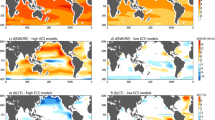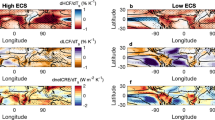Abstract
The effects that low clouds in sub-tropical to tropical latitudes have in determining a given model’s climate sensitivity is investigated by analyzing the cloud data produced by 16 “slab” or mixed-layer models submitted to the PCMDI and CFMIP archives and their respective response to a doubling of CO2. It is found that, within the context of the 16 models analyzed, changes of these low clouds appear to play a major role in determining model sensitivity but with changes of middle cloud also contributing especially from middle to higher latitudes. It is noted that the models with the smallest overall cloud change produce the smallest climate sensitivities and vice versa although the overall signs of the respective cloud feedbacks are positive. It is also found that the amounts of low cloud as simulated by the respective control runs have very little correlation with their respective climate sensitivities. In general, the overall latitude-height patterns of cloud change as derived from these more recent experiments agree quite well with those obtained from much earlier studies which include increases of the highest cloud, decreases of cloud lower down in the middle and lower tropospheric and small increases of low clouds. Finally, other mitigating factors are mentioned which could also affect the spread of the resulting climate sensitivities.
Similar content being viewed by others
References
Bony S, Dufresne J-L (2005) Marine boundary layer clouds at the heart of tropical cloud feedback uncertainties in climate models. Geophys Res Lett 32:L20806. doi:10.1029/2005GL023851
Cess RD, Potter GL, Blanchet JP, Boer GJ, Del Genio AD, Déqué M, Dymnikov, Galin V, Gates WL, Ghan SJ, Kiehl JT, Lacis AA, Le Treut H, McAvaney BJ, Meleshko VP, Mitchell JFB, Morcrette J-J, Randall DA, Rikus L, Roeckner E, Royer JF, Schlese U, Sheinin DA, Slingo A, Sokolov AP, Taylor KE, Washington WM, Wetherald RT, Yagai I (1990) Intercomparison and interpretation of climate feedback processes in 19 atmospheric general circulation models. J Geophys Res 95:16601–16615
Cess RD, Zhang MH, Ingram WJ, Potter GL, Alekseev V, Barker HW, Cohen-Solal E, Colman RA, Dazlich DA, Del Genio AD, Dix MR, Esch M, Fowler LD, Fraser JR, Galin V, Gates WL, Hack JJ, Kiehl JT, Le Treut H, Lo KK-W, McAvaney BJ, Meleshko VP, Morcrette J-J, Randall DA, Roeckner E, Royer JF, Schlesinger ME, Sporyshev PV, Timbal B, Volodin EM, Taylor KE, Wang W, Wetherald RT (1996) Cloud feedback in atmospheric general circulation models: an update. J Geophys Res 101:12791–12794
Colman R (2003) A comparison of climate feedbacks in general circulation models. Clim Dyn 20:865–873
Gregory J, Webb M (2008) Tropospheric adjustment induces a cloud component in CO2 forcing. J Clim 21:58–71
Hansen J, et al (1984) Climate sensitivity: analysis of feedback mechanisms, Climate Process and Climate Sensitivity, Geophysical Monograph, 29, Maurice Ewing 5: Amer Geophys Union 130–163
Karlsson J, Svensson G, Rodhe H (2007) Cloud radiative forcing of subtropical low level clouds in global models. Clim Dyn 30:779–788
Manabe S, Wetherald R (1980) On the distribution of climate change resulting from an increase of CO2 content of the atmosphere. J Atmos Sci 37:99–118
Medeiros B, Stevens B, Held I, Zhao M, Williams D, Olsen J, Bretherton C (2008) Aquaplanets, climate sensitivity, and low clouds. J Clim 21:4974–4991
Meehl GA, Stocker TF, Collins WD, Friedlingstein P, Gaye AT, Gregory JM, Kitoh A, Kunitti R, Murphy JM, Noda A, Raper SCB, Watterson IG, Weaver AJ, Zhao Z-C (2007) Global Climate Projections, Chapter 10 in Climate Change 2007. The Physical Science Basis, Working Group I Contribution to the Fourth Assessment Report of the Intergovernmental Panel on Climate Change. Cambridge University Press, Cambridge
Mitchell J, Ingram W (1992) Carbon dioxide and climate: mechanisms of changes in cloud. J Clim 5:5–21
Randall DA, Wood RA, Bony S, Colman R, Fichefet T, Fyfe J, Kattsov V, Pitman A, Shukla J, Srinivasan J, Stouffer RJ, Sumi A, Taylor KE (2007) Climate models and their evaluation. In: Climate change 2007: the physical science basis, Working Group I Contribution to the Fourth Assessment Report of the Intergovernmental Panel on Climate Change. Cambridge University Press, Cambridge
Roads J (1978) Numerical experiments on the sensitivity of an atmospheric hydrologic cycle to the equilibrium temperature. J Atmos Sci 35:753–773
Schneider S, Washington W, Chervin R (1978) Cloudiness as a climate feedback mechanism: effects on cloud amounts of prescribed global and regional surface temperature changes in the NCAR GCM. J Atmos Sci 35:2207–2221
Senior C, Mitchell J (1993) Carbon dioxide and climate: the impact of cloud parameterization. J Clim 6:393–418
Senior C, Mitchell J (2000) The time-dependence of climate sensitivity. Geophys Res Lett 27:2685–2688
Soden B, Held I (2006) An assessment of climate feedbacks in coupled ocean-atmosphere models. J Clim 18:237–273
Wetherald R, Manabe S (1980) Cloud cover and climate sensitivity. J Atmos Sci 37:1485–1510
Wetherald R, Manabe S (1986) An investigation of cloud cover change in response to thermal forcing. Clim Change 8:5–23
Wetherald R, Manabe S (1988) Cloud feedback processes in a general circulation model. J Atmos Sci 45:1397–1415
Williams K, Tselioudis G (2007) GCM intercomparison of global cloud regimes: present-day evaluation and climate change response. Clim Dyn 29:231–250
Wilson C, Mitchell M (1987) A doubled CO2 sensitivity experiment with a global model including a simple ocean. J Geophys Res 92:13315–13343
Zhang M, Bretherton C (2008) Mechanisms of low cloud-climate feedback in idealized single-column simulations with the community atmospheric model, Version 3 (CAM3). J Clim 21:4859–4878
Author information
Authors and Affiliations
Corresponding author
Rights and permissions
About this article
Cite this article
Wetherald, R.T. The role of low clouds in determining climate sensitivity in response to a doubling of CO2 as obtained from 16 mixed-layer models. Climatic Change 109, 569–582 (2011). https://doi.org/10.1007/s10584-011-0047-3
Received:
Accepted:
Published:
Issue Date:
DOI: https://doi.org/10.1007/s10584-011-0047-3




